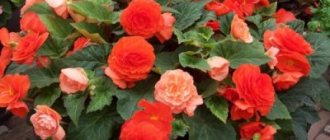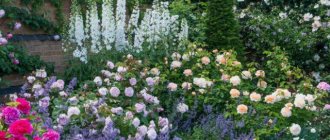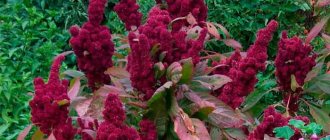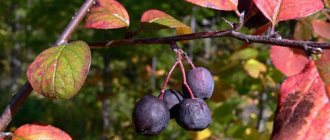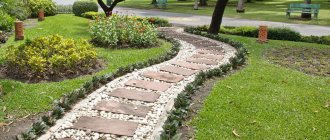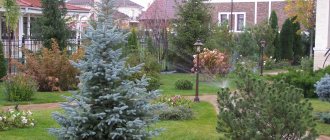Let's find out in more detail what flower lawns exist and what their pros and cons are.
The information from this article will allow you to create flower-strewn lawns at your summer cottage with your own hands. You will become familiar with the intricacies of selecting and sowing grass mixtures and the features of caring for ornamental lawns.
Moorish lawn, photo
What is Moorish lawn?
Several centuries ago, during the reign of the Moors, many areas intensively developed on the African continent and in Spain: architecture, science, etc. This period also saw the active development of landscape decor. Luxurious architectural buildings, palace complexes and picturesque parks - all this splendor was built in those distant years.
The Moorish lawn with meadow grasses formed the basis of luxurious gardens, striking the imagination with their beauty, located within the palace complexes.
In the palace parks, the Moors embodied the idea of a lawn with flowers, similar to a meadow landscape, but being an integral part of the landscape composition. Residents of European countries borrowed the idea of their southern neighbors to decorate lawns with flowering plants that grew mainly in meadows.
In addition to cereals and lawn grasses, the Moorish lawn usually includes 10-15 species of beautifully flowering low-growing annuals: gum, red and blue flax, cornflowers, poppies, daisies, etc.
The main advantage of using Moorish lawns in landscape design is that they look very beautiful and require a minimum of maintenance.
If you want to decorate your garden area, but are not eager to spend time regularly mowing and caring for a classic lawn, sow a mixture of flowers. In stores you can buy ready-made herbs (such mixtures have different names). In most cases, they include herbs and cereals (from 70 to 90%) and various flowering plants (about 10-30%).
You can make your own herbal mixture. Lawn grass is used as a base, and flowers that you like are added to it.
Recommendation: follow the proportions when preparing a mixture of herbs for decorating a Moorish lawn at your summer cottage.
The composition of the grass mixture will determine the appearance of the lawn, the flowering period of the grasses and the durability of the flower lawn.
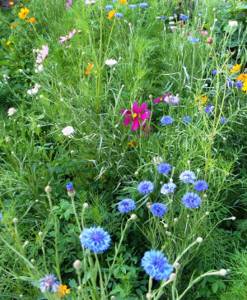
Moorish lawns come in different types:
- containing tall vegetation;
- low, decorated with low plants;
- monochrome, including, in addition to greenery, flowers of the same variety and color;
- multi-colored - from a variegated mixture of cereal crops and various flowering vegetation.
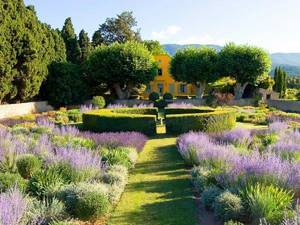
Moorish lawns are the highlight of the oriental gardens and parks that amaze with their splendor.
Vegetation for arranging a flowering lawn should be selected in such a way that it has different flowering periods, otherwise the lawn will delight you with its beautiful design for a short time.
To get a clearer picture of how a Moorish-style lawn will look, look at photos of gardens that have such lawns. Variegated colors are appropriate in gardens decorated in an oriental or country style.

A man-made meadow in the design of a garden looks very impressive. The design of the site will look even more beautiful if you install a gazebo on such a lawn.
When arranging a Moorish lawn area, a lawn border tape will certainly come in handy - a useful thing for distinguishing between different plantings and preventing soil erosion.
The features of decorating flower beds along the paths are described in this article.
DIY Moorish lawn
It is not always possible to use the services of a landscape designer or gardener, and in this case, it makes sense to create a Moorish lawn with your own hands. Despite the many advantages of the Moorish lawn, the disadvantage is the randomness of plant growth. This is due to the lack of regular haircuts. That is why, when creating a Moorish lawn with your own hands, it is better to allocate only a small area for plant cover, located between fruit trees or near the walls of the house.
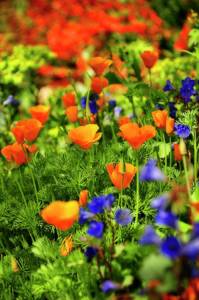
The more different types of flowers, the brighter and more colorful the lawn looks.
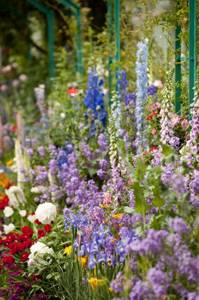
Luxurious herbs will be a wonderful decoration for your garden plot
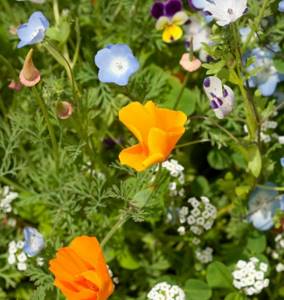
In gardening stores you can select ready-made seed mixtures for sowing Moorish lawns
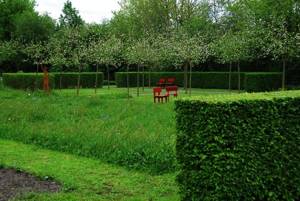
Different ratios of grass to meadow flowers, as well as in different months, change the appearance of the Moorish lawn
Also among the pros and cons of the Moorish lawn, it is worth noting the ability of the coating to renew itself and grow on any type of soil. On the one hand, this reduces the work of planting new plants, on the other hand, it reduces the ability to control the appearance of the coating. The obvious disadvantage of the Moorish lawn is the inability to trim already faded plants before their seeds fall. The advantage of the Moorish lawn is its natural appearance and small area for planting.
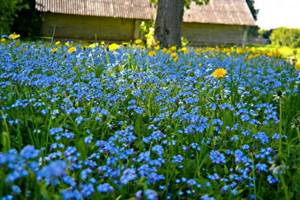
Delicate lawn of forget-me-nots and dandelions
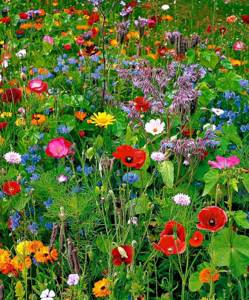
The multicolored Moorish lawn
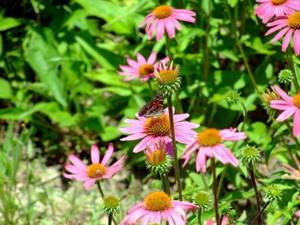
Meadow flowers make up the bulk of crops for the Moorish lawn
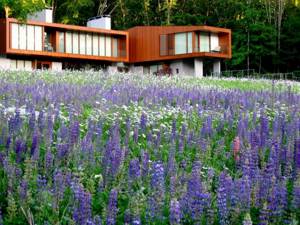
Luxurious carpet of delicate white and blue flowers in front of the house
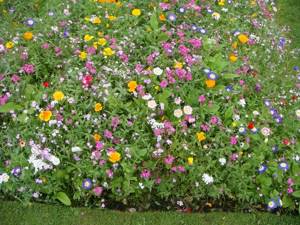
The multicolored Moorish lawn
Also, one of the disadvantages of the Moorish lawn is that flowers for decorating the covering are usually chosen as annual bulbous ones, which is why every year you need to set aside time to plant new plants and remove faded ones.
Advice! To make it easier to trim faded annual plants, they should be placed along the edges of the lawn.
Advantages and disadvantages of Moorish style lawns
If you compare the Moorish lawn with a traditional lawn, it turns out that floral garden design has many more pros than cons.
In addition to the fact that such a lawn looks colorful and presentable, it has the following positive features:
- Does not need constant haircuts . Two haircuts per season will be enough. It is better to trim the Moorish lawn for the first time in the spring, when cereal crops begin to actively grow, and perennial plants and flowers have just sprouted. The second time such a lawn is mowed is in the fall, after the flowering period of most plants has ended and the seeds have fallen.
- Does not require constant care ; Agrotechnical work is carried out to a minimum.
- From one month to the next, the number of certain plants naturally changes , causing the lawn to look different. Vegetation is more easily renewed due to the fact that in the intervals between adjusting its height, the seeds have time to ripen and disperse.
- If bald spots appear on the lawn, it is easy to level them out by planting seedlings of annual plants or sowing fast-growing flowering crops.
- Able to grow on scanty, poor soils , for this you only need to periodically feed the plants.

A Moorish-style lawn can be combined with a classic lawn.
Despite the obvious advantages, this coating also has disadvantages:
- When making your own herbal mixture, you need to carefully consider its composition. If the mixture is not prepared correctly, there is a high probability that some plants will prevent the growth of others, some of the vegetation will not tolerate low temperatures in winter, and the lawn will not look aesthetically pleasing.
- Such a coating performs only a decorative function. Landscape decor with a Moorish-style lawn is not intended for games and picnics, as the flowers are easily damaged and trampled.
- Lawns that occupy a large area take a lot of time to maintain. On large sites, the likelihood increases that the vegetation will no longer be controllable and will transform into an unkempt meadow. For this reason, flowering herbs are planted in small islands.
Important! When creating a mixture of grasses for your lawn, take into account the height of the vegetation, its flowering period and frost resistance.
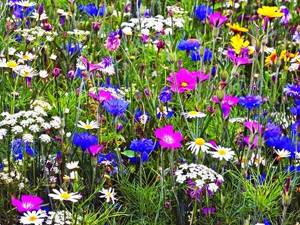
Moorish lawn: technology of creation and cultivation
Compared to preparing the soil for a classic green lawn, pre-cultivating the soil for a Moorish lawn is not as labor-intensive. Step-by-step instructions for preparing the soil:
- The soil is dug up to a depth of about 20 cm.
- All weeds are removed along with roots and stones.
- The surface is leveled.
- Poor soils are fertilized with organic or mineral fertilizers; on ordinary soils, fertilizing is not required.
- The soil is compacted and watered abundantly.
The optimal time for planting a Moorish lawn is the first half of autumn or the second half of spring. Sowing in summer is not recommended. Experienced gardeners practice differentiated sowing of Moorish lawns: cereal seeds are sown in the fall, and flowering plants are sown in the spring. But most hobbyists prefer standard simultaneous seeding.
Sowing is carried out at the rate of 5-10 g of seeds per 1 sq.m. The easiest way is to scatter the seeds using a seeder, but sowing by hand is also acceptable. To do this, you need to divide the lawn area into equal areas and distribute the seeds over them. Then the sown seeds are raked and rolled, or sprinkled with soil. It would not be amiss to create a shelter for crops from non-woven material. You need to prepare for uneven emergence of seedlings - the interval can be up to 1 month. At first, young shoots need constant soil moisture until their height reaches 10 cm.
DIY Moorish lawn: video
Creating a floral design
Creating a piece of a beautiful oriental-style garden on your own backyard is a realistically feasible task. To successfully implement this idea, you need to choose the right vegetation and follow the recommendations for creating a flower lawn.
How to select plants for a presentable combination? If you decide to arrange a flowering meadow in the Moorish style yourself, the first thing you need to do is to choose the right varieties of herbs and flowers suitable for your garden.
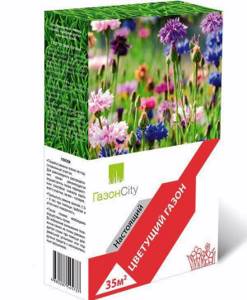
Tip: choose perennials that do not suffer from proximity to plants of other species.
Annual plants that delight with their flowering for one season should be selected that produce seeds without problems, self-disperse, and sprout in the spring at the same time.
What types of plants do Moorish lawns include? Remember that this is still a lawn, albeit a flowery one, and not a flower bed. Most of it should be sown with cereal crops.

Some of the most popular types of grasses suitable for mid-latitudes include the following:
- meadow bluegrass;
- fragrant bison;
- red blooming fescue;
- meadow timothy.
Cereals in the grass mixture should occupy from 70 to 90%. If you do not have experience creating flower lawns, choose mixtures consisting of 85% lawn grass varieties. A lawn with a large number of plants is more difficult to maintain.
What does a Moorish lawn look like?
If, driving past a house, you see an amazingly beautiful lawn planted with grass, a variety of wildflowers, the combination of which from a distance resembles a colorful oriental carpet, rest assured - this is a Moorish meadow lawn.

Its difference from traditional lawns is that, in addition to the lush green grass, it contains a large number of diverse, small flowers, providing flowering for almost the entire warm season.
The most popular annual and perennial plants
Flowering vegetation is chosen so that different varieties bloom at different times. In spring, bulbous plants and early varieties of perennials will delight with variegated colors, after which annual flowers will bloom, creating an aesthetic picture for almost the entire season.
The most popular annual plants suitable for Moorish lawns include the following:
- self-dispersing field poppy;
- marigold;
- various types of cornflowers;
- chamomile;
- low types of cosmos;
- flax with large flowers.
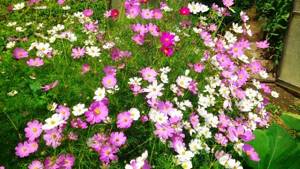
On a note! Cosmea harmonizes perfectly with cereal crops.
A distinctive feature of these species is their ability to randomly disperse seeds. This eliminates the need to regularly plant new vegetation - the cover is renewed naturally.
The most popular perennial plants for the Moorish lawn:
- echinacea;
- meadow nivaria;
- perennial varieties of gypsophila;
- Lavender angustifolia.
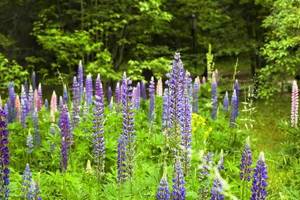
All of these plants are unpretentious and can easily tolerate mowing.
Early bulbous varieties for Moorish-style lawns:
- tulips;
- cockerels;
- daffodils;
- various types of decorative onions;
- crocuses.
The photo below shows an example of a Moorish lawn made of bulbous flowering plants:
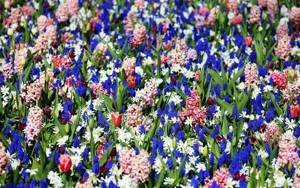
Choice of colors
If you want variegated flowers to begin to please your soul after the first thaw, we recommend planting early-flowering bulbs:
- hyacinths
- crocuses
- tulips
- muscari
- snowdrops and blueberries.
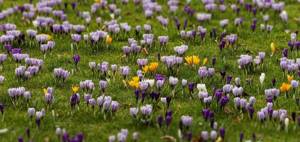
Most garden primroses, except the last two, have several hybrids and varieties of different colors and shades, which makes it possible to get a variegated Moorish carpet immediately after the snow melts. But it is worth considering that many of the bulbous plants gradually lose their decorative value if the bulbs are not dug up for the summer. If you are not afraid of this prospect, then you can use them as part of perennial Moorish lawns.

Perennials that look good include:
- echinacea
- lavender
- yarrow, both wild and garden
- Carpathian bell
- Common cornflower (meadow daisy)
- oriental poppy
- tansy
- gaillardia, etc.
The use of annual flowers, such as cosmos, snapdragons, cornflowers, flax and many others, also pays off. If you plan to change the style of your lawn every year, you can sow only annuals or a mixed composition.
It is worth noting that the ratio of herbs to flowers should be in favor of cereals, approximately 8:2. This proportion is not accidental - the basis of the Moorish lawn is made up of carpet plants, which give it a well-groomed appearance, in contrast to wild meadows.
Subtleties of landing
Let's figure out what is the difference between planting a traditional lawn and creating a Moorish-style lawn. A site for a flower carpet should be selected with good lighting, since in areas shaded by trees or buildings it is difficult to create a thick covering of ornamental plants.
When considering how to properly create a Moorish lawn, you need to first think about when to plant the grass mixture. In this case, the characteristics of the plants that make up the lawn should be taken into account. For example, it is better to sow a herbal mixture consisting of intensively growing cereal crops and annual plants in early spring, while perennial bulbous varieties should be planted in the fall.
Look how beautiful the variegated forbs look in the photo:
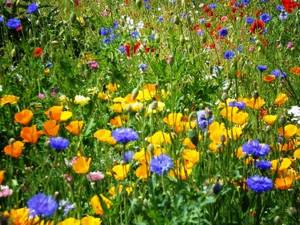
Spring sowing
Moorish lawn seeding should be done in windless conditions. The soil should be slightly moist, but not dry or flooded.
How to plant a Moorish lawn in spring? Let's look at the step-by-step sowing of plants:
- If the area needs to be cleared of weeds, this work should be done in the fall. Be sure to remove all wild grass roots and treat the soil with herbicides. Remove 8-10 cm of soil to remove all weed roots and seeds.
- With the arrival of spring, when the ground thaws and dries, dig it up with a shovel. If the soil is fertile, additional fertilizer is not necessary. Add 50-60 grams to poor soil during digging. fertilizers based on phosphorus and nitrogen per square meter.
- Sowing begins in the second decade of April or early May, depending on climatic conditions. Before planting the seeds, the soil is leveled with a rake and compacted.
- To distribute the seeds evenly, the herbal mixture is mixed with sand in a ratio of 1:3 (sand should be used dry). The prepared mixture is sown in the prepared soil.
- To plant seeds in the ground, use a rake, making short strokes, as when weeding. The immersion depth of the seeds is 1-2 cm. After this, the soil is compacted with a roller.
- Agrofibre serves as a protective covering for the lawn. It is also necessary to install sprinklers for irrigation. The soil needs regular moistening. After the first shoots appear, the covering fabric is removed.
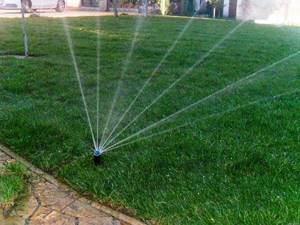
Sowing in autumn
Planting in the autumn is done so that perennial plants and bulbous varieties have time to take root before spring. The period for laying a lawn occurs at the end of summer and beginning of autumn, before the cold weather sets in.
Step by step planting:
- Before planting a Moorish lawn in the autumn, a couple of weeks before sowing the plants, the area must be cleared of weeds and dug up. Poor soils are enriched with complex additives at the rate of 60-70 g. per one square meter.
- Right before planting, weeds are removed again and then the soil is leveled with a rake.
- First of all, shrubby perennial plants and bulbous varieties are planted. It is recommended to place small plants in groups of 5 or in islands. After planting, the soil is loosened again and leveled with a rake.
- The area that remains unplanted is sown with a herbal mixture (30-50 grams per square of land). The seeds are immersed in the soil with a rake and then compacted with a roller.
- Humidity is usually high in autumn, so there is little need for additional irrigation. If there is no rain, the lawn is irrigated with sprinklers.

Varieties and styles of Moorish lawn
The herbaceous and flower lawn is divided into two groups according to the set of plants:
- single-color;
- variegated.
Single-color, that is, one-color, is when the composition of such a lawn includes colors that are close in the group, for example, from blue to dark blue. Variegated – as the name suggests, an extravaganza of colors in a small area.
A Moorish lawn may not even contain flowers at all, but can be created with a predominance of different types of cereal plants. Yes, there are such types. Also, it can contain both annual and perennial flowers and herbs .
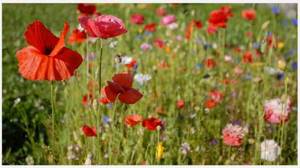
Features of care
Despite the fact that lawns decorated with flowering vegetation look extremely natural, they also need care.
Only with proper care does the covering of herbs and flowers acquire the most attractive appearance. What are the features of caring for a Moorish lawn? Considering that meadows decorated with meadow flowers can be either perennial or annual, their agricultural maintenance may be different. First of all, this applies to adjusting the height of the coating; other activities related to lawn care are almost identical.
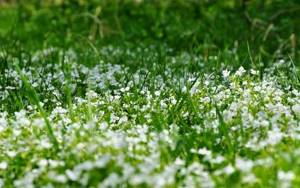
How to do a haircut correctly
A perennial Moorish-style lawn is cut or mowed twice per season. The first mowing is done after the cereal crops have risen: the cutting is carried out in order to create the same conditions for the growth of vegetation of different types.
But this is done only in the first year; in subsequent years, the lawn is cut in late spring - early summer, and also after the seeds have ripened and scattered - in mid-autumn. If plant growth is intense, most likely you will have to cut the clearing a second time at the end of summer. The height adjustment is made by 8-12 cm.
A clearing containing bulbous varieties is trimmed only after their leaves are completely dry. This is required so that the plant bulbs can stock up on nutrients for the winter.
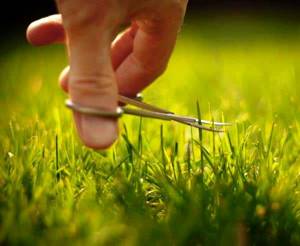
The Moorish lawn, consisting of annual plants, is first cut before the flowers rise, and cut again after the seeds have dispersed. The timing of adjusting the height of the cover may vary and depend on certain plant varieties. You need to monitor the condition of the lawn and adapt to the growth stages of the flowers.
Throughout the growing season, it is necessary to monitor so that the artificial meadow is not overrun by weeds. Harmful plants have to be removed manually. Weeding with a hoe or using herbicides is not permissible, as this will damage all ornamental vegetation.
Moorish lawn: description and composition of plants
Observing this lawn for the first time, you may get the impression that in front of us is a meadow glade , which shimmers with a variety of colors, capable of delighting the owner with an unforgettable floral aroma throughout the entire growing season. The reason that this lawn can bloom without interruption for so long is the following: this effect is achieved due to the fact that the seeds for sowing are correctly selected for it, where special attention is paid to the timing and duration of their flowering.
Actual Moorish lawns can be considered a type of meadow lawn. They are also united by the fact that vegetation that is already present on the site is used to organize it. As a rule, we are talking about meadow and lawn grasses. Also, this type of lawn is distinguished by a variety of beautiful flowering plants , among which there are such as:
- Persian chamomile;
- field poppies;
- Carpathian bell;
- forest forget-me-not;
- clove-herb;
- perennial daisy;
- marigold;
- dye coreopsis;
- tobacco;
- linen;
- mignonette, etc.
Most often, seeds of annuals and perennials . The choice of mixture must be approached especially carefully, since this will determine how long the herbal flower carpet will please you. Some lawns can remain in good condition for no longer than a year, while others effectively perform their function for several years.
Flower crops are just one of the main plants of the Moorish lawn. It also contains turf-forming grasses, thanks to which the lawn can not only delight the owner with its decorative appearance, but for many years does not require its reconstruction. First of all, the following lawn plants have such properties:
- ryegrass;
- bluegrass;
- fescue;
- bentgrass, etc.
Using such plants, you can create elastic and dense turf . At the same time, in order to achieve optimal results, sowing seeds for this lawn must be carried out in a certain order:
- first you need to sow turf-forming grasses;
- Flower crops are sown after them.
Irrigation and fertilizing rules
In the first twenty days after planting, you need to especially carefully monitor the soil moisture.
Important! Don't let the soil dry out, especially if it's hot outside. Even a short drought can damage germinating seeds and destroy seedlings.
Irrigation can be reduced only after seedlings of all types of plants appear on the lawn. Small lawns can be irrigated using a sprinkler with a fine sieve. In large areas, it is more convenient to install sprinklers or use drip irrigation systems.
Clearings dotted with flowers require almost no feeding. If the vegetation begins to wither, fertilizing additives are added during the next irrigation. For this purpose, urea, saltpeter and ammonia are spread throughout the area at the rate of 10-20 g. per square meter of land. Stores also sell complex fertilizer additives for flowering lawns. Before using them, you should read the instructions on the packaging.
Choosing a ready-made mixture for the Moorish lawn
As this type of lawn gains popularity, garden centers are stocked with packages of compounds to suit every taste. Take the pack you like and study its composition. Select a mix based on the environmental conditions you are willing to provide.
There are mixtures for:
- Shaded places;
- Dry areas;
- Waterlogged areas;
- Universal.
Often a flowering lawn is sown along the fence or a small island is organized against the background of a regular lawn, where it creates a beautiful contrast. Also, a small cheerful clearing can be an accent near a group of decorative trees, a bench, a recreation area, or a bathhouse.
Decoration options
There are many ways to combine plants. Among the ready-made herbal mixtures there are mixes consisting of 10-15 cereal crops and several dozen varieties of flowers. If you want to make your own mixture, it is recommended to use proven combinations.
To create an annual Moorish lawn, a meadow variety of mint, red-blooming fescue, and flax with large flowers are suitable.

Lawns decorated in a rustic style look like wild meadows.
For a perennial meadow, fragrant bison, crocuses, cockerels, narrow-leaved lavender, and lupine are suitable.
The photo below shows a Moorish lawn in a rustic style:
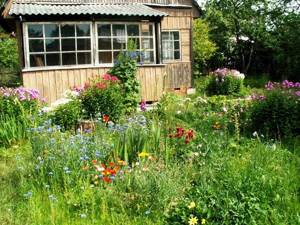
To prevent the lawn from losing its presentable appearance during the intervals between the flowering of perennial plants, a small amount of seeds of annual flowers, for example, calendula or low cosmos, can be included in the herbal mixture.
Read about how to create a beautiful blooming rose garden at your dacha with your own hands: photos and placement diagrams of shrubs, criteria for choosing rose varieties for original flower beds.
You can see photos of fast-growing hedge plants in the article here.
A list of garden perennial flowers that bloom all summer is in the article at:
With proper care, a flowering lawn will delight the eye for several years. Decorating a lawn in a Moorish style will add some zest to the landscape decor of your summer cottage.
Moorish lawn care
Such a lawn does not need to be fertilized or watered if the plants are well selected and adapted to the environment. Care consists of mowing several times a season.
How and when to mow a Moorish lawn?
The timing of mowing affects the character of the meadow.
- The meadow, which should be at its most beautiful in spring, should be mowed for the first time at the end of June, when the flowers have faded (preferably to a height of 10 cm), and then mowed several more times until autumn.
- If our task is to organize a flowering Moorish lawn in the summer, then we need to mow it to a height of 10 cm before mid-June. Then it will bloom in July, and in September it will look like a flowering carpet. Then you should mow it in October after flowering.
- Dry meadows, where plants grow slowly, do not need to be mowed all season. It is better to mow at the end of September.
Moorish lawn is very easy to maintain. Under favorable conditions and with the appropriate selection of mixtures, it is enough to mow it only once a year. However, to achieve and maintain the best results over time, it is worth remembering a few simple procedures that will help us maintain the meadow in good condition.
Watering
Flowering plants have much greater drought tolerance and are more commonly used than grasses. The meadow can survive water shortages, which are fatal for classic lawns. Watering is recommended only in very severe drought and after sowing seeds. If, after sowing the seeds, the soil does not maintain adequate moisture for germination, germination may be delayed until conditions are favorable.
Weed control
If the soil has not been properly prepared, for example it may be too fertile or the seeds have been sown incorrectly, the meadow may become overgrown with weeds. If there are too many of them, they can compromise the growth of flowering plants. To prevent this, the meadow should be mowed to a height of 15-20 cm above the ground. Thanks to this operation, the flowers will have a chance to develop normally. Mowing too late can result in annual plants not flowering. In the case of perennial plants, mowing as weed control can be done several times a season in the first year. This will eliminate weeds and allow meadow plants to grow lushly next year.
Soil fertilization
Moorish lawn usually consists of flowering plant species that do not require additional fertilizer. This applies primarily to mixtures containing seeds of wild plants. These mixtures are also not recommended for use in areas where fertilizers have previously been used. This is due to the fact that such plants grow more slowly than regular weeds. Additional fertilization can stimulate the growth of weed species.
